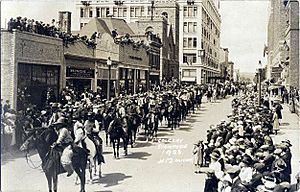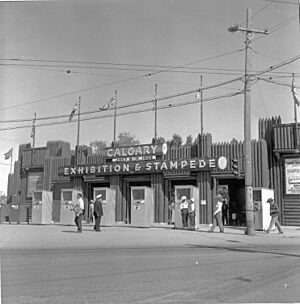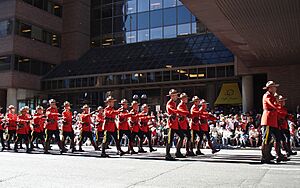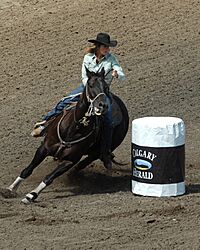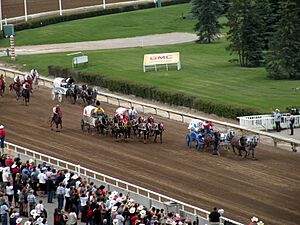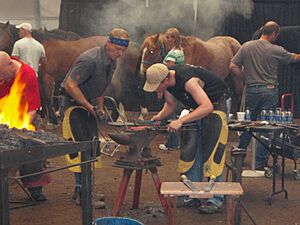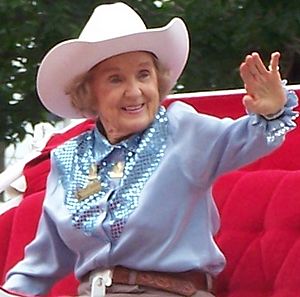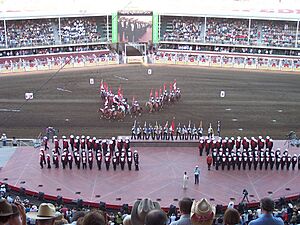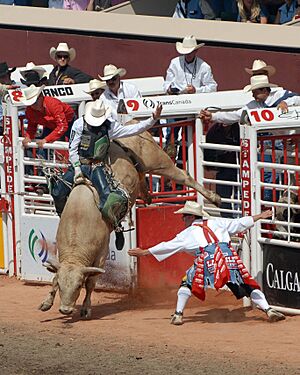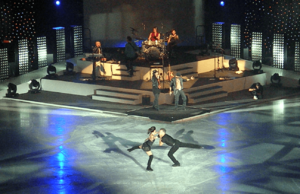Calgary Stampede facts for kids
Quick facts for kids Calgary Stampede |
|
|---|---|
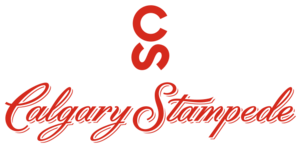 |
|
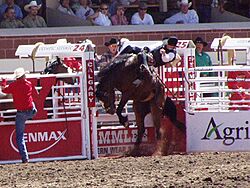
Bareback bronc rider at the Stampede rodeo
|
|
| Genre | Rodeo and fair |
| Dates | 10 days, starting the first Friday of July (second Friday if the first Friday is Canada Day or the day after Canada Day) 2025: July 4–13 |
| Location(s) | Calgary, Alberta, Canada |
| Founded | 1886 (Exhibition) 1912 (Stampede) 1923 (Exhibition and Stampede) |
| Attendance | 1,470,288 (2025) 1,477,953 (record – 2024) |
The Calgary Stampede is a huge yearly event in Calgary, Alberta, Canada. It happens every July and is a mix of a rodeo, a big exhibition, and a festival. People call it "The Greatest Outdoor Show on Earth." Over one million visitors come each year.
The Stampede has one of the world's largest rodeos. It also features a big parade, a fun midway with rides, live stage shows, concerts, and farm animal competitions. You can also see exciting chuckwagon racing and learn about First Nations cultures. In 2008, the Calgary Stampede was honored by being added to the ProRodeo Hall of Fame.
The event started way back in 1886 as a local fair. In 1912, an American showman named Guy Weadick created his own rodeo and festival called the Stampede. He brought it back in 1919 to celebrate soldiers returning from World War I. Weadick's festival became a yearly event in 1923. That's when it joined with the Calgary Industrial Exhibition to become the Calgary Exhibition and Stampede.
Thousands of volunteers and city leaders help organize the Calgary Stampede. It has grown into one of the richest rodeos in the world. It is also one of Canada's biggest festivals and a major tourist attraction. Rodeo and chuckwagon races are even shown on TV across Canada.
Calgary is often called the "Stampede City" or "Cowtown" because of this event. The city's Canadian Football League team is even called the Stampeders. During the Stampede, the whole city gets into a party mood. Buildings are decorated, people wear western wear, and there are many pancake breakfasts and barbecues everywhere.
Contents
History of the Calgary Stampede
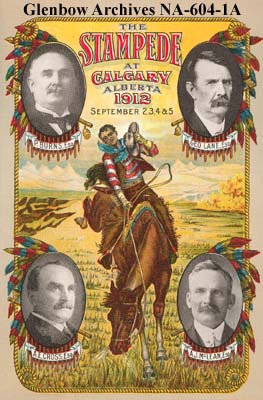
The Calgary and District Agricultural Society started in 1884. Its goal was to promote the town and encourage farmers and ranchers to move west. Their first fair was in 1886. About a quarter of the town's 2,000 people attended. By 1889, they had land near the Elbow River for exhibitions. But due to bad crops and a struggling economy, the society stopped in 1895. The land later became Victoria Park. A new company started hosting fairs there in 1899.
The exhibition grew each year. In 1908, Calgary hosted the big Dominion Exhibition. The city spent a lot of money (C$145,000) to build new buildings and a racetrack. They had a grand parade, rodeo, horse racing, and trick roping contests. The exhibition was a big success. It brought 100,000 people to the fairgrounds, even though Calgary only had 25,000 residents.
Guy Weadick, a trick roper from the United States, came to Calgary in 1912. He wanted to create an event that truly showed the "wild west." He convinced four rich businessmen—Pat Burns, George Lane, A. J. McLean, and A. E. Cross—to put up $100,000 to fund his idea. These men became known as the Big Four. They saw the event as a way to celebrate their lives as cattlemen. The city built a rodeo arena. Over 100,000 people came to the six-day event in September 1912. Cowboys from Canada, the U.S., and Mexico competed for $20,000 in prizes. The event made $120,000 and was a big hit.
Weadick tried to plan another Stampede in 1913, but the Big Four were not interested. He tried in other cities, but those shows didn't make money. Weadick returned to Calgary in 1919. He got support for a "Great Victory Stampede" to celebrate soldiers returning from World War I.
The Calgary Exhibition and Stampede Union
The 1919 Stampede was successful, but it was still a one-time event. E. L. Richardson, the manager of the Calgary Industrial Exhibition, believed it could be a profitable yearly event. The exhibition board was not interested at first. However, their fair was losing money and attendance was dropping. So, in 1922, they agreed to try merging the two events. Weadick agreed, and this created the Calgary Exhibition and Stampede.
The first combined event was in 1923. Weadick encouraged everyone in Calgary to dress in western clothes. He also asked businesses to decorate in a "wild west" style. City leaders, including Mayor George Webster, supported the event. They even closed downtown roads for two hours each morning for street parties. The new sport of chuckwagon racing was introduced and became very popular right away. The event had 138,950 attendees and made a profit. By 1924, over 167,000 people came, making sure the Stampede and Exhibition would stay together forever.
Attendance grew through the 1920s, reaching a peak of 258,496 in 1928. But the Great Depression caused attendance to drop and the event to lose money. After losses in 1930 and 1931, the board had to cut costs. This caused problems between the board and Weadick. Weadick felt the board was taking too much control of his event. In 1932, Weadick was removed from his duties. He sued the board and won some money, but he was still upset. Weadick didn't get along with the board for 20 years. He was finally invited back as an honored guest in 1952.
Many movies were filmed at the Stampede. The 1925 silent film The Calgary Stampede used rodeo footage. This movie showed the event to people all over North America. Famous Hollywood stars like Bob Hope and Bing Crosby visited. Even Queen Elizabeth II and Prince Philip visited the Stampede twice, in 1959 and 1973.
Growth and Expansion
After oil was discovered nearby in 1946, Calgary grew very quickly. The city's population almost doubled between 1949 and 1956. Newcomers to Calgary loved the Stampede and encouraged their friends and family to visit. The 1950s were a "golden age" for the Calgary Stampede.
Attendance records were broken almost every year in the 1950s. The number of visitors increased by 200,000 from 1949 to 1959. This growth meant the fairgrounds needed to expand. The 7,500-seat Stampede Corral was finished in 1950. It was the largest indoor arena in Western Canada. It hosted the Calgary Stampeders hockey team. Famous musicians like Louis Armstrong also played there.
Improvements were made to the grandstand and racetrack in 1954. The Big Four Building opened in 1959. It was named after the Stampede's original supporters. This building was the city's largest exhibition hall in the summer. In winter, it became a huge curling facility. Even with these improvements, there were still problems with parking and not enough tickets for the rodeo and shows.
Attendance kept growing in the 1960s and 1970s. It passed 500,000 visitors in 1962 and reached 654,000 in 1966. Organizers made the event longer, from six days to nine in 1967, and then to ten days the next year. The Stampede had over one million visitors for the first time in 1976. The park also continued to grow. The Round-Up Centre opened in 1979. The Olympic Saddledome was finished in 1983. The Saddledome became the city's main sports arena. Both the Saddledome and the Corral hosted hockey and figure skating events for the 1988 Winter Olympics.
Keeping the focus on farming and western traditions was important as Calgary grew. "Aggie Days," a program to teach city kids about agriculture, started in 1989 and was very popular. A ten-year plan called Horizon 2000 was released in 1990 to make Stampede Park a year-round destination. The Calgary Exhibition and Stampede organization changed its name to simply the Calgary Stampede in 2007. Attendance has been around 1.2 million since 2000. However, the Stampede set a record of 1,409,371 visitors in 2012 for its 100th anniversary.
Recent Challenges
Severe flooding hit Calgary in 2013, just two weeks before the Stampede was set to open. The grounds were badly damaged. But Stampede officials promised the event would still happen. Some main events and all concerts in the Saddledome were cancelled due to flood damage. Other events were moved to different places.
In 2020, the Stampede was cancelled for the first time in almost a century. This was because of the COVID-19 pandemic. Some smaller, safe events were held instead. These included drive-through pancake breakfasts and fireworks. The cancellation had a big economic impact.
In 2021, the Stampede decided to hold an in-person event. It was "very different" to follow public health rules. The Rangeland Derby was cancelled for the second year. Admission to Nashville North required proof of vaccination or a negative rapid test. The parade was held inside Stampede Park with no public spectators. This was because the city did not allow it on public streets. Instead of the Rangeland Derby, bronc riding events were added to the rodeo.
The decision to hold the Stampede in 2021 had mixed reactions. Some worried it could spread COVID-19. However, Alberta Health Services later said only 71 cases were linked to the Stampede. This was out of 528,998 attendees.
Stampede Events
The Grand Parade
The parade officially opens the Stampede. It starts early on the first Friday. Each year, a different person is chosen as the parade marshal. These are often politicians, athletes, or actors. The parade has many marching bands, over 150 floats, and hundreds of horses. It mixes western themes with modern ones. Cowboys, First Nations dancers, and members of the Royal Canadian Mounted Police in their red uniforms join clowns and bands. The first Stampede parade in 1912 had 75,000 people. This was more than the city's population at the time! In 2011, Prince William and Catherine, the Duke and Duchess of Cambridge, attended. This helped bring a record 425,000 people to the parade.
The parade was smaller and closed to the public in 2021 due to the COVID-19 pandemic.
The Rodeo Competition
The rodeo is the main part of the Calgary Stampede. It is one of the biggest and most famous rodeos in the world. It offers huge prizes, with $100,000 for the winner of each main event. The total prize money on championship day alone is $1,000,000. Cowboys love performing in front of over 20,000 fans every day.
There are six main events: bull riding, barrel racing, steer wrestling, tie down roping, and saddle bronc and bareback riding. There are also four events for younger or newer riders. These include junior steer riding and wild pony racing. Competitors are divided into two groups. The top four from each group go to the Sunday final. Others compete on Saturday for a wild card spot. The person with the best score or time on Sunday wins the $100,000 grand prize.
Most of the animals for the rodeo come from the Stampede Ranch. This ranch is about 22,000-acre (89 km2) big. It was started in 1961 to improve the quality of bucking horses and bulls. It also makes sure there are enough animals for the rodeo. The Stampede Ranch is the first of its kind in North America. It breeds some of the best rodeo animals in the world. It also supplies animals to rodeos across Alberta and even as far as Las Vegas.
Rangeland Derby Chuckwagon Racing
Guy Weadick is said to have invented chuckwagon racing in 1923. He wanted a new and exciting event for the combined Exhibition and Stampede. Weadick invited ranchers to enter their wagons and teams. They competed for $275 in prize money.
The official name is the Rangeland Derby. People also call it the "half-mile of hell" or the "dash for cash." It became popular very quickly and is now the biggest attraction. In 1923, only six teams raced. Today, 36 teams compete for $1.15 million in prize money. Joe Carbury was the famous voice of the Rangeland Derby for 45 years. His special way of saying "and they're offfffffff!" at the start of a race made him a local legend.
Chuckwagon drivers sell advertising space on their wagons before each Stampede. This started in 1941. The money from these auctions, which reached a record $4 million in 2012, shows how strong Calgary's economy is.
The Rangeland Derby was cancelled in 2020 and 2021 due to the COVID-19 pandemic.
The Exhibition Hall
When the agricultural exhibition started in 1886, Alberta was mostly a farming area. Today, fewer people work in agriculture. But the exhibition is still a very important part of the Calgary Stampede. Almost 70% of all Stampede visitors go to the Agriculture Zone. They see displays, demonstrations, and western events. Many competitions are held, like the World Series of Cutting and the World Championship Blacksmith Competition. There are also demonstrations of farm animals, stock dog trials, and team penning competitions.
The exhibition also teaches people about Alberta's ranching and farming history. It shows how modern food is produced. The Stampede works with Alberta 4-H clubs to encourage young people to get involved in agriculture.
Midway Fun
The Calgary Stampede midway has been run by North American Midway Entertainment since 1976. The midway is the only part of the event that makes a profit. It is a key part of the Stampede, but it is separate from the western theme. The midway opens on the Thursday night before other events, called "sneak-a-peek" night. Besides rides and games, the midway has four concert areas. Nashville North, a big party tent, started in 1993 for country music. The Coca-Cola Stage offers many types of music. The Saddledome hosts big music acts. In 2018, The Big Four Roadhouse opened as a new concert venue.
The Stampede Market
The Stampede Market is inside the BMO Centre. It has 38,000 square metres (410,000 sq ft) of shopping space. Since 2019, it has focused on local artists. The Western Oasis, a part of the market, sells cowboy and western-themed art, statues, crafts, food, and wine. Many vendors want to sell their goods here because over a million people visit the Stampede. Some wait years to get a spot.
Stampede Park Grounds
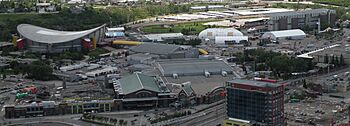
Stampede Park is located southeast of Downtown Calgary. You can get there easily by Calgary Transit's light rail system. The park has many permanent buildings. These include the Saddledome, Big Four Building, BMO Centre (for conventions), Cowboys Casino, the Stampede Grandstand, and the agriculture building.
The park is still in its original spot. There were plans to move it in 1964, but people living nearby did not want it. Space was always a problem. In 1968, a plan to expand into the Victoria Park community started many conflicts. These lasted for decades.
Victoria Park slowly declined. Finally, in 2007, the last buildings were removed. This allowed Stampede Park to expand and the area to be renewed. With the land secured, the Stampede started a $400-million expansion. This plan includes new shops, an urban park, a new agricultural arena, and possibly a new hotel. The project was expected to be finished by 2014.
Stampede Park has always been a central meeting place for Calgarians and tourists. Besides the Calgary Stampede, over 2.5 million people attend other events there each year. The park hosts over 1,000 events annually, including sports, concerts, and trade shows.
People of the Stampede
Each year, a Stampede Queen and two princesses are chosen. They are selected through a contest for young women aged 19 to 24 who live in Alberta. They need good horsemanship skills and must be good representatives for the Stampede and Calgary. The first Stampede Queen, Patsy Rodgers, was chosen in 1946. The princesses were added the next year. The queen and princesses serve for one year. They make hundreds of appearances across Alberta and North America. After their term, they join the Calgary Stampede Queens' Alumni Association. This group raises money for organizations that help children with special needs.
First Nations Participation
During each Stampede, the five nations of the Treaty 7—the Tsuu T'ina, Piikani, Stoney, Kainai and Siksika—set up a camp. It is on the bank of the Elbow River in the southern part of Stampede Park. It was called the Indian Village, but was renamed Elbow River Camp in 2018. They put up tipis, hold pow wows, sell arts and crafts, and show parts of their traditional way of life. Each year, an Indian Princess is chosen from one of the five nations to represent Treaty 7. The camp is one of the Stampede's most popular attractions.
First Nations people have been part of Calgary's exhibitions since 1886. They took part in parades and sports. They also entertained people with traditional dances. By 1912, government agents tried to stop them from participating. But Guy Weadick wanted them in his Stampede. He got support from politicians in Ottawa. This allowed First Nations people to be part of the event.
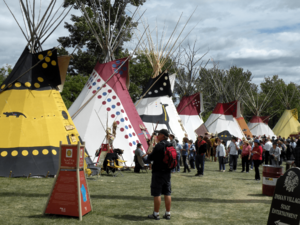
Hundreds of Indigenous peoples from six tribes took part in the 1912 Stampede. They camped in tipis and wore their best traditional clothes. They were very popular in the parade. Tom Three Persons, from the Blood (Kainai) tribe, became one of the Stampede's first heroes. He won the saddle bronc competition. He was the only Canadian champion of the first Stampede. He was also the first person to successfully ride Cyclone, a horse that had thrown over 100 riders.
The government tried to stop First Nations participation again in 1914. They changed the Indian Act to make it illegal for Indigenous peoples to be in fairs without permission. This stopped them from being in the Calgary Exhibition. But when Weadick returned in 1919, he fought for their return. The Indian Affairs Department tried to ban them again in 1925, but failed. Conflicts continued until 1932, but the Indian Village stayed. It has been a main part of the grounds ever since.
First Nations members and the Stampede board have had some disagreements. The original Indian Village location often flooded. This problem was fixed in 1974 when the village moved. There have been complaints about low payments to tipi owners and not enough say in decisions. But despite these issues, the First Nations communities around Calgary strongly support the Stampede and the Indian Village. Many tipi owners are third or fourth generation participants. The Stampede has helped keep First Nations cultures alive and show them to the public. In 2016, the village moved again, doubled in size, and showed the partnership between the city, First Nations, and the Stampede.
In 2018, the Indian Village was renamed "Elbow River Camp." This change was made to show "reconciliation and increased understanding of Indigenous peoples as modern and strong and resilient."
Volunteers and Staff
Running Stampede Park all year needs 300 full-time and 1,400 part-time employees. An extra 3,500 seasonal workers are hired just for the Stampede. Many young people in Calgary get their first jobs filling these seasonal positions.
However, the organization is mostly run by volunteers. Over 2,000 volunteers work on 50 committees. These committees handle everything about the Stampede. The board of directors has 25 members. Many volunteers have served for over 10 years, some even for 60 years.
Young Canadians of the Calgary Stampede
In 1964, the Calgary Stampede brought in The Rockettes from New York City for the grandstand show. They also auditioned young local dancers to be "Calgary Kidettes." This group was very popular and became a regular part of the show. By 1968, the Kidettes were renamed the Young Canadians of the Calgary Stampede. They became a main act by the 1970s. The group was inspired by the American group Up with People. They performed on TV and live across North America. In 1982, the Stampede Foundation started the Young Canadians School of Performing Arts. It offers professional training to singers and dancers aged 7 to 19. Scholarships from the Stampede pay for this training.
The Stampede Showband
The Stampede Showband started in 1971. They are the musical ambassadors for the organization. The group has over 150 members aged 16 to 21. They have won the world championship for marching show bands seven times, most recently in July 2023. The Showband has performed all over the world. They played at the opening ceremonies of the 1988 Winter Olympics. In 2019, they performed the national anthem at the 107th Grey Cup. The Showband performs all year. They make over 100 appearances during the Stampede alone. They performed in the Tournament of Roses Parade in Pasadena, California for the third time in 2012. This was part of the Stampede's 100th anniversary. The Showband also plays "O Canada" every night during the chuckwagon races. The Stampede Showriders started in 1985. They are a precision equestrian drill team that performs with the Showband.
Calgary Stampede Talent Search
The Calgary Stampede Talent Search began in 1981. It is a yearly competition for amateur artists aged 13 to 21. Younger performers (aged 6 to 12) also get to show their talents every evening. This competition happens during the Stampede. It aims to find and help talented young people from southern Alberta.
Animal Welfare and Safety
The Stampede tries to balance rodeo traditions with concerns from animal welfare groups. These groups say the sport is not kind to animals. Stampede officials say the animals are "stars of the show." They state that the Stampede cares deeply about treating animals properly. The Calgary Humane Society works with the Stampede to make sure animals are not too stressed. They are one of two groups, along with veterinarians, who watch the rodeo.
Chuckwagon racing is a particular area of concern. The World Professional Chuckwagon Association has called the Stampede's Rangeland Derby "a half-mile of hell." From 1986 to 2015, 65 horses died in this event. Animal rights groups protest, saying the sport causes too much suffering for the horses. Racers agree the sport is dangerous. But they defend it, saying the animals are well cared for. They also say that allowing them to race saves many horses from being sent to slaughter too early.
After many accidents in 1986, where nine horses died in chuckwagon races, people called for changes. Some even wanted the sport banned. Many new rules were made before the 1987 event. The Calgary chapter of the Society for the Prevention of Cruelty to Animals accepted these changes. They did not call for a ban because the Stampede worked to improve animal safety. More rule changes were announced in 2011.
Tie down roping is another event that some groups want to stop. The Stampede changed its rules in 2010 to follow the Canadian Professional Rodeo Association rules. The Stampede was also the first rodeo to give a penalty if a competitor made a dangerous tackle in steer wrestling. More changes were made in 2011 after six animals died at the 2010 Stampede.
Even with these changes, accidents still happen. Horses and other animals have died. In 2005, a group of about 200 horses got scared during a trail ride. Nine horses died after being pushed off a city bridge into the Bow River. Stampede officials said they would not do any more trail rides unless they could make sure the horses were safe.
Animal welfare groups say animal deaths are "predictable." They want people to boycott the rodeo. In the United Kingdom, travel agencies have been asked to stop offering tours to the Stampede. In 2010, many UK politicians asked Canadian politicians to ban rodeo. Some groups asked the Duke and Duchess of Cambridge to cancel their visit in 2011. However, the royal couple attended and watched a private demonstration of rodeo and chuckwagon events.
Animal Casualties in Recent Years
| Year | Details |
|---|---|
| 2024 | 3 horses in Chuckwagon race; 1 steer in steer wrestling |
| 2023 | 1 horse in Chuckwagon race |
| 2022 | 1 horse in Chuckwagon race |
| 2019 | 6 horses in Rangeland Derby chuckwagon race |
| 2018 | 1 horse |
| 2017 | 1 horse |
| 2016 | no casualties |
| 2015 | 4 horses |
| 2014 | 1 horse in Chuckwagon race; 1 steer in steer wrestling |
| 2010 | 6 horses in Rangeland Derby chuckwagon race |
Broadcasting the Stampede
Live coverage of the rodeo and Rangeland Derby is broadcast by the CBC Sports website and Sportsnet One. CBC Television shows daily highlights and weekend coverage. In 2019, the U.S. channel CBS Sports Network aired nightly half-hour recaps of the rodeo. CBS also broadcast a one-hour highlight show of the championship. In 2021, rodeo coverage moved to Sportsnet in Canada and The Cowboy Channel in the United States.
Community Spirit
The festival spirit during Stampede spreads throughout the city. Parade day is like an unofficial holiday. Many companies give employees time off to attend. People from all jobs wear casual western clothes, like Wrangler jeans and cowboy hats. Many Calgarians feel more relaxed during the event. The community and company events during the Stampede are great for meeting people. They also help new residents feel at home in the city. The Stampede is an important stop for political leaders on their yearly summer tours.
Pancake Breakfasts
Pancake breakfasts are a local tradition during Stampede. Dozens are held across the city every day. Community groups, companies, churches, and politicians host them. The tradition started in 1923. A chuckwagon driver named Jack Morton invited people passing by to join him for breakfast.
The biggest breakfast is at the Chinook Centre shopping mall. Four hundred volunteers are needed to feed over 60,000 people at this one-day event. The Calgary Stampede Caravan group feeds as many as 120,000 people over ten days. The popularity of barbecue grills in the 1960s and the city's growth led to many community and company barbecues during Stampede. Calgary groups have shared this tradition across Canada. For example, the Calgary Grey Cup Committee has hosted pancake breakfasts on the day of the Canadian Football League championship game for over three decades.
Stampede Parties
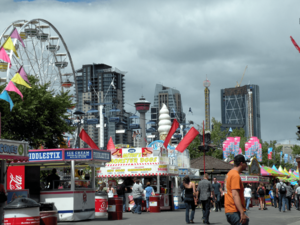
The number of parties during Stampede shows how strong Calgary's economy is. Companies and community groups hold big events for their staff and clients. Bars and pubs set up party tents. The largest tents can attract up to 20,000 people a day. Some business owners say they make up to 20 percent of their yearly income during the ten days of Stampede.
Calgary's Connection to the Stampede
The Stampede is strongly linked to Calgary's identity. Calgary has long been called the "Stampede City" and "Cowtown." The event's famous status gives Calgary global attention. It plays a big role in how the city is seen. Calgary's Canadian Football League team has been called the Stampeders since 1945. Other sports teams in the city have also used this name.
The Stampede has strong support in Alberta. A 2006 poll found that 86 percent of Albertans felt it improved the city's quality of life. They saw it as one of the region's most important cultural events. Almost three out of four people said they look forward to it every year.
The Stampede's success is partly due to its close relationship with the city government and community leaders. Calgary mayors and city council members have served on the Stampede Board. The Stampede operates on city-owned land and does not pay property tax on its lease. It usually faces little political interference. It operates as a non-profit organization. All money earned is put back into the park.
The media also supports the Stampede. Local newspapers have been criticized for giving too much positive coverage. In 2009, both major newspapers refused to run anti-rodeo ads. The Calgary Sun said it was because they were Calgarians and did not want outsiders to insult a Calgary tradition. The Calgary Herald later changed its mind and ran an ad in 2010.
Economic Benefits and Tourism
While 70 percent of Stampede visitors are from the Calgary area, officials promote the event worldwide. The Calgary Stampede is known around the world. It attracts visitors mainly from the United States, the United Kingdom, and Australia. More tourists are also coming from Asia and South America.
A 2019 report found that the Calgary Stampede's year-round activities bring in $540.8 million across Alberta. The 10-day event alone accounts for $282.5 million of that. In Calgary, the Stampede's year-round activities bring in $449.8 million. Of that, $227.4 million comes from the 10-day Stampede.
In 2025, Stampede organizers reported that the 10-day event was on track to break the attendance record set in 2024. Over 812,000 visitors were counted by July 8. One day, TC Energy Community Day, had 193,033 visitors. The 2025 event was expected to bring in about $282 million for the economy.
Stampede officials estimated in 2009 that the 10-day event alone had an economic impact of $172.4 million on Calgary. The total for the province was $226.7 million. The Stampede is the highest-earning festival in Canada. Officials also estimate that for every dollar spent at Stampede Park, tourists spend $2.65 in the rest of the city. A 2011 poll found that 40 percent of Calgarians planning to attend expected to spend $150–$400 during the event.
Promoting Calgary's Image
City leaders have always noted the Stampede's impact on Calgary. Mayor Andrew Davison said in 1944 that the event "had done more to advertise Calgary than any single agency." Later mayors have agreed. Stampede officials also say the event is one of Canada's most important tourist attractions. The Canadian Tourism Commission has included the Stampede in its Signature Experiences Collection.
According to Ralph Klein, a former mayor of Calgary and premier of Alberta, the Stampede shows the spirit of the province. He mentioned the friendly and welcoming attitude of the city's people during the event. Community groups share this spirit around the world. One famous example is the 1948 Grey Cup game. Two trains full of Stampeder football fans went to Toronto. They had huge celebrations before, during, and after the game. This included riding a horse into the lobby of the Royal York Hotel. These events helped turn the Grey Cup into a national festival.
See also
 In Spanish: Calgary Stampede para niños
In Spanish: Calgary Stampede para niños
- Calgary White Hat
- Canadian Finals Rodeo, Canada's other big rodeo
- Canadian Professional Rodeo Association
- Chuckwagon
- Festivals in Alberta
- Festival Western de Saint-Tite, eastern Canada's largest rodeo
- Raymond Stampede, Canada's oldest rodeo
- Reg Kesler


